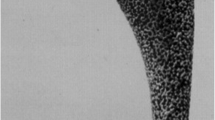Abstract
Recent reports in the literature strongly support the idea that cement is the optimum form of fixation of the femoral component in total hip replacement. For hybrid total hip arthroplasty, we used a cemented cup instead of an uncemented cup since this was inevitable in cases of poorly developed acetabulum. The uncemented cone femoral component is also beneficial in cases of extremely narrow and cylindrical configuration of the medullary cavity of untreated congenital dislocation of the hips (CDH) and tuberculosis or septic arthritis in childhood. We reviewed the clinical result of a consecutive series of patients with cemented total hip arthroplasty (THA) compared with recent studies on hybrid reconstruction using survivorship analysis. This subsequent study involved a hybrid uncemented Wagner cone femoral component and a cemented acetabular component with roof reinforcement by additional impacted cancellous allograft with hydroxyapatite (HA). We believe that early failure of the cemented components was due to an adverse effect of thin cement mantles around cemented femoral stems as well as the cemented cup in THA. In addition, 8 patients who received our modification of the Charnley CDH component had poor results even though we reduced the stem geometry and thickness. Furthermore, intraoperative fracture and splitting of the proximal femur was a major complication during implantation. Contrary to expectations, the results of these hybrid reconstructions were extremely encouraging (average follow-up period of 2–4.5 years). In addition to our experience of the cemented versus hybrid THA involving the uncemented Wagner femoral component, we have determined positive indications for the untreated and severely distorted anatomy of bilateral CDH for which surgical interventions for reconstruction were not recommended before.
Similar content being viewed by others
References
Barlow TG (1962) Early diagnosis and treatment of congenital dislocation of the hip. J Bone Joint Surg [Br] 44:292
Brash JC (1955) Neuro-vascular hila of limb muscles. E & S Livingstone Edinburgh, pp 50–69
Buhler DW, Berlemann U, Frei HP, Nolte LP (1995) Three dimension motion of femoral prosthetic stems: an in vitro evaluation of a novel measuring concept. Orthopaedic Research Society, 41st Meeting, Orlando, Fla.
Charnley J (1979) Low friction arthroplasty of the hip. Theory and practice 130-1
Charnley J, Feagin JA (1973) Low-friction arthroplasty in congenital subluxation of the hip. Clin Orthop 91:98–113
Davey JR, Harris WH (1989) A preliminary report of the use of a cementless acetabular component with a cemented femoral component. Clin Orthop 245:150–115
DeLee JG, Chanley J (1976) Radiological demarcation of cemented sockets in total hip replacement. Clin Orthop 121:20–32
Dunn HK, Hess WE (1976) Total hip reconstruction in chronically dislocated hips. J Bone Joint Surg [Am] 58:838–845
Gerber SD, Harris WH (1986) Femoral head autografting to augment acetabular deficiency in patients requiring total hip replacement: a minimum five-year and an average seven-year follow-up study. J Bone Joint Surg [Am] 68:1241–1248
Gie GA, Ling RSM, Timperley AJ, Linder L, Simon JP, Sloof TJJH (1993) Impacted cancellous allografts and cement for revision total hip arthroplasty. J Bone Joint Surg [Br] 75:18–20
Harley JM, Wilkinson JA (1987) Hip replacement for adults with unreduced congenital dislocation. J Bone Joint Surg [Br] 69:752–755
Harris WH, Malonly WJ (1989) Hybrid total hip arthroplasty. Clin Orthop 249:21–29
Hess WE, Umber JS (1978) Total hip arthroplasty in chronically dislocated hips: follow-up study on the protrusio socket technique. J Bone Joint Surg [Am] 60:948–954
Kim YY, Ko CU, Lee SW, Kwak BM (1979) Replacement arthroplasty using the Charnley prosthesis in old tuberculosis of the hip. Int Orthop 3:81–88
Kim YY, Alm JY, KO CU, Yoon YS, Kwak BM (1988) Chamley low friction arthroplasty in tuberculosis of the hip: an eight to 13-year follow-up. J Bone Joint Surg [Br] 70:756–760
McKibbin B (1970) Anatomical factors in the stability of the hip joint in the newborn. J Bone Joint Surg [Br] 52:158–159
Murray DW, Carr AJ, Bulstrode C (1993) Survival analysis of joint replacements. J Bone Joint Surg [Br] 75:697–704
Schenk RK, Wehrli U (1989) Zur Reaktion des Knochens auf eine zementfreie SL-Femurrevisionsprothese. Orthopade 18:454–462
Wagner H, Wagner M (1995) Conical stem fixation for cementless hip prostheses for primary implantations and revision. In: Morscher E (ed) Endoprosthetics. Springer, Berlin Heidelberg New York, pp 258–267
Campbell's operative orthopedics, 8th ed, Vol. I. Arthroplasty. p 518
Author information
Authors and Affiliations
Rights and permissions
About this article
Cite this article
Kim, Y.Y., Kim, B.J., Ko, H.S. et al. Total hip reconstruction in the anatomically distorted hip. Arch Orthop Trauma Surg 117, 8–14 (1998). https://doi.org/10.1007/BF00703431
Received:
Issue Date:
DOI: https://doi.org/10.1007/BF00703431




